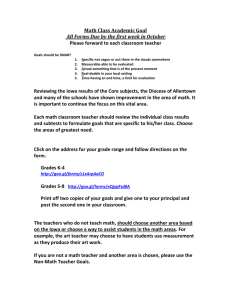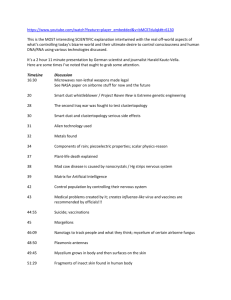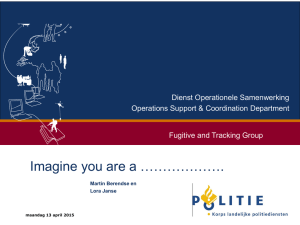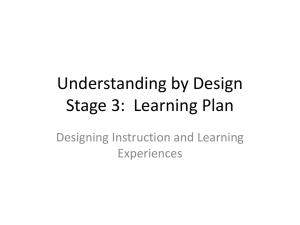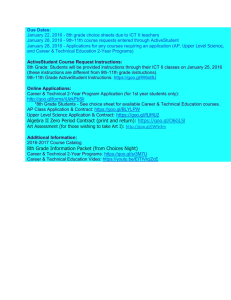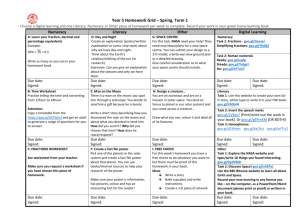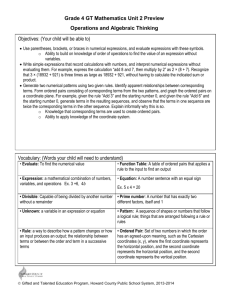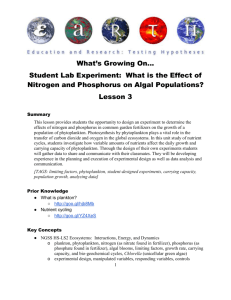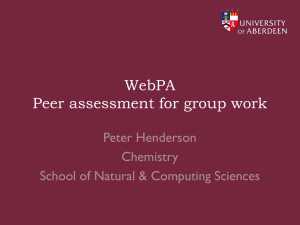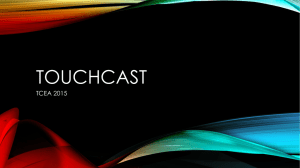Modernism Powerpoint
advertisement
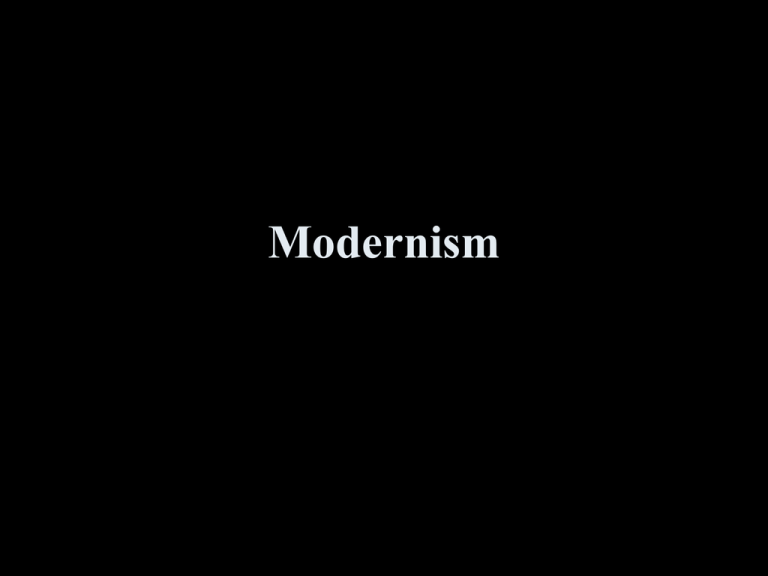
Modernism Where are we coming from? Romanticism (@1750-1865?) •Values – the individual – the imagination – feeling – emotion – wonder – nature • Beliefs – Truth of subjective realities – Inherent innocence and goodness of humans Realism/Naturalism (1865-1914?) • Response to rapid changes – Post war industrialization (war is a victory of the industrial over the agrarian) – Urbanization – Immigration (factory workers) – Science and technology (e.g. phonograph, light bulb, train, telephone, etc.) Naturalism (the philosophical roots of realism) • Idealism and reverence for individual realities are weak and avoid the messy complexities of the “real” world. • Freud, Darwin, and Marx: Human actions are driven by repressed fears and desires (the unconscious), the physical environment (survival of the fittest), and socioeconomics (relations between the haves and have-nots—or between capital and labor). • Tell me what your relationship with your mother/father was like, how much money you make, and where you live and I’ll tell you what you fear, desire, and think. • And on top of all that, the universe is completely, totally, utterly, absolutely indifferent to those fears, desires, and thoughts. It is “amoral” and ambivalent. The literary/artistic response: Realism (a technique) • Empiricism trumps intuition and subjectivity: truth is verified by experience. • Observation of the objective and the individual response to it. • Mimetic art: portray life as it is lived in the world of conditions. • That is, portray ordinary people (e.g. Harte’s outcasts of poker flat, Crane’s boatmen and hotel guests, London’s dying men), • speaking like ordinary people (e.g. Twain’s storyteller, the characters in The Awakening), • struggling against their fears/desires (e.g. Edna, Farquar), their immediate physical environment (e.g. “The Open Boat,” “The Law of Life,” “To Build a Fire”), and social/economic forces (e.g. the Swede, Daisy Miller, Sylvia) Modernism 1914-1945? • century ideas take root, flower, and produce poisoned fruit: • Science becomes “scientism.” Culture created by science/technology— Freud (unconscious), Darwin (environment), Marx (socioeconomics). 19th • Birth of mass communication and popular culture—an attack on the “local” and the “commodification” of culture (language, beauty, morality become co-opted, bought, and sold). • Time/Space relations change: the automobile, suburbs (changes notions of “home,” “here,” and “soon.”) • “Free market capitalism” rationalizes and institutionalizes disparities between capital and labor (i.e. the haves and have-nots). • “Great migration”--increases diversity in culture, language, and social structures—and incoherence and stability of communities. • The biggie: World War I. A new kind of war. • Bottom line: life is fundamentally different, and “old” or traditional ways of Alienation: The Heart of Modernism • • • • • From culture (“pop culture” and “the masses”). From society (the Depression, growing rich/poor gaps). From politics (world war and the political “elites”). From nature (scientism, technology, urbanization). From self (you think what you think and do what you do because of either unconscious drives that are out of your control [Freud] or because of social conditioning out of your control [behavioralists]). • From meaning (the world is a meaningless, chaotic, Godless place where humans impose meaning): “God is dead”—Nietzsche. So, what if you wake up one day and realize all the world’s a meaningless mess? What do you do? • You search for and/or create meaning and clarity. • Life is a quest for meaning, and the quest, not the particular meaning, becomes the subject of art. • Allusions to archetypes, mythology, and history are common in modernist literature. They allow the writer and the reader to participate in the crafting of a human history in a meaningless world. • Perspective, subjectivity, and the experience of these becomes the subject of art (cynical, despair-riddled romantics, sort of). So what does this mean for literature? • Fragments, unresolved conflicts, and open endings rather than coherent, resolved wholes. • Ambiguity, idiosyncrasy, subjectivity, irrationality. • Literature should be an artistic “experience”—not a lesson or a commentary or something otherwise corrupted by its connection to the world. • “Art for art’s sake”—form privileged over content. • Use of the disillusioned “anti-hero”—who lives by a personal code that demands vigilance against traditional, but fraudulent, heroic codes of allegiance to social and political institutions. • Representation of the inner life—the psychological reality and “flow of experience”—stream of consciousness. Cubism Every aspect of the whole subject, broken down into fragments, analyzed, reassembled and portrayed simultaneously in a single dimension. Woman Playing a Mandolin, Picasso, The Head of a Woman, Picasso Dadaism Anti-art. Reflected irrationality and cynicism toward social values. Sometimes absurd and playful, emotive and intuitive, and often cryptic. Response to a world gone mad. Bride Striped Bare, Marcel Duchamp Bicycle Wheel, Marcel Duchamp Expressionism Seeks to present the inner life of humanity rather than its outward appearance. The Scream, Edvard Munch Interior of the 4th Dimension, Max Weber Impressionism • Depict/evoke the feeling or experience of the thing rather than the thing. • Focus on light and color, not on lines (believed that we see light not matter). • Visible brush strokes (calls attention to the individual process of creation). Water Lilies, Claude Monet Renoir Imagism: Early Modernist Poetry • Use the language of common speech. • Use the exact word and use no extraneous words— precision and concision. • Avoid clichés. • Create “moods.” • Present a concentrated image (and an image for concentration). • Suggest, rather than dictate. Ezra Pound on Imagism: “An ‘Image’ is that which presents an intellectual and emotional complex in an instant of time.” An image “gives that sense of sudden liberation; that sense of freedom from time limits and space limits; that sense of sudden growth, which we experience in the greatest works of art.” “In a Station of the Metro,” Pound (1913) The apparition of these faces in the crowd: Petals on a wet, black bough. “The Red Wheelbarrow,” WC Williams so much depends upon a red wheel barrow glazed with rain water beside the white chickens. Cubism Every aspect of the whole subject, broken down into fragments, analyzed, reassembled and portrayed simultaneously in a single dimension. Picasso, Seated Nude Picasso, The Head of a Woman Dadaism Reflected irrationality and cynicism toward social values. Sometimes absurd and playful, emotive and intuitive, and often cryptic. Response to a world gone mad. “Anti-art.” Max Ernst, untitled Marcel Duchamp, Nude Descending a Staircase Marcel Duchamp, Bicycle Wheel Hydrometric Demonstration of how to Kill by Temperature, Max Ernst Expressionism Seeks to present the inner life of humanity rather than its outward appearance. A heightened reality, often via the non-objective use of symbols, stereotyped characters, and stylization, in order to give objective expression to inner experience Lavender Mist, Jackson Pollock Study for Woman, Willem De Kooning Surrealism A means of reuniting conscious and unconscious realms of experience so completely that the world of dream and fantasy would be joined to the everyday rational world in "an absolute reality, a surrealist“(quote from Andre Breton). Drawing heavily on theories adapted from Sigmund Freud, surrealists saw the unconscious as the wellspring of the imagination. Lobster Telephone, Salvador Dali Persistence of Memory, Salvador Dali The Age of Enlightenment, Rene Magritte I am the Walrus, Beatles Yellow matter custard dripping from a dead dog's eye Crabalocker fishwife pornographic priestess Boy you been a naughty girl You let your knickers down I am the eggman, they are the eggmen I am the walrus, goo goo goo joob Semolina pilchard climbing up the Eiffel Tower Elementary penguin singing Hare Krishna man You should have seen them kicking Edgar Alan Poe I am the eggman, they are the eggmen I am the walrus, goo goo goo joob goo goo goo joob Goo goo gooooooooooo jooooob Loser, Beck In the time of chimpanzees I was a monkey Butane in my veins and I’m out to cut the junkie With the plastic eyeballs, spray-paint the vegetables Dog food stalls with the beefcake pantyhose Kill the headlights and put it in neutral Stock car flamin’ with a loser and the cruise control Baby’s in reno with the vitamin d Got a couple of couches, sleep on the love-seat Someone came in sayin’ I’m insane to complain About a shotgun wedding and a stain on my shirt Don’t believe everything that you breathe You get a parking violation and a maggot on your sleeve So shave your face with some mace in the dark Savin’ all your food stamps and burnin’ down the trailer park
